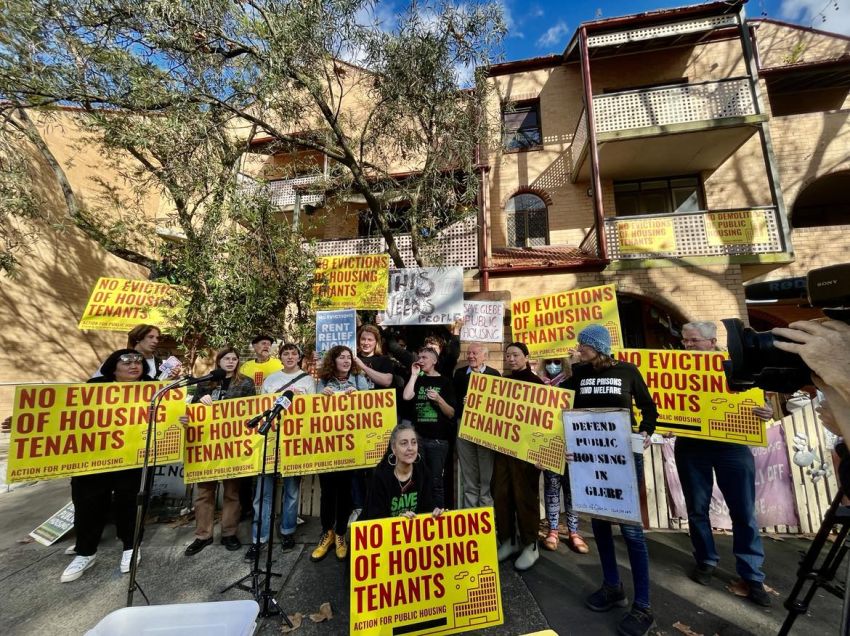
As the housing affordability crisis goes from bad to worse, blame is being apportioned to the wrong culprits — the latest being “NIMBYs”, the so-called “Not in my back yard” resident activists who are accused of blocking new housing in their neighbourhoods.
Ignored by economist Chris Richardson, NSW Premier Chris Minns, Real Estate Institute New South Wales and former Reserve Bank economist Tony Richards, is the $20 billion in annual investor tax concessions which increasingly turn housing into a profitable financial instrument.
Throw in declining levels of public housing, through privatisation, non-existent rent controls and growing levels of vacant properties and more obvious reasons for the spiralling cost of housing become apparent.
Let’s examine what resident action groups have and haven’t been able to achieve, against the power of developers.
During the Green Bans movement of the 1970s, resident action groups, in cooperation with the Builders Labourers Federation (BLF), managed to save large areas of low-cost housing and force new public housing to be built in Woolloomooloo, The Rocks (notably the Sirius building) and Eastlakes.
This movement also managed to preserve Kellys Bush and Centennial Park from a huge stadium complex.
Green Bans were only begun with direct support from the local community. Resident action groups managed to achieve significant gains alongside socially conscious unions, despite immense pressure from the developer lobby.
The BLF was eventually deregistered by the Bob Hawke Labor government and since then, resident power to stop demolitions has declined.
Despite large-scale resident opposition, including with some major party support, the Sirius building was sold, converted to luxury private apartments. The wasteful demolition and rebuild of Sydney Football Stadium also went ahead at a cost of $800 million.
Arguably, the biggest resident-led campaign of the last decade in Sydney was against the $20 billion private WestConnex toll road, which destroyed many homes, and runs counter to any semblance of sustainable urban development.
A 2017 City of Sydney report, WestConnex – Alternative Proposal proposed using the site of the now St Peters WestConnex interchange for housing for 11,000 people. Despite support for that idea, given the location is close to transport and jobs, the government evicted residents from their homes.
For the major parties, land for homes is a lower priority than land for cars and private toll road builders.
Liberal Premier Mike Baird sought to further weaken resident power through his council amalgamation policy and planning laws, such as State Significant Development, which overrides resident input at the local level.
Profiteering
Overlaying the current housing crisis and wider urban development questions is a much more regressive force — capitalism. In a system run by the profit motive, nice places to live become expensive places to live. This is the obvious explanation for gentrification.
When certain places can retain good public facilities and access to jobs, they become highly sought after, and prices rise. Eventually, only the wealthy can afford to live there.
The solution is to make more, not less, nice places to live. This includes more public housing at affordable rents allowing people of all backgrounds to live in vibrant, diverse neighbourhoods, with great amenities.
A similar dynamic is at play with “transit-oriented development” (TOD). The idea is to build more housing close to existing public transport. This is not a new idea and has considerable merit. The flipside is to build more public transport close to existing housing.
But TOD casts public transport as rare and expensive: it lets governments off the hook for building public transport and gives a free gift to developers who land-bank close to train stations, and wait for upzoning to build apartment towers. Governments use the excuse that they cannot afford to build better public transport unless density is greatly increased. But there is little supporting evidence for that.
Sydney Metro problem
The Sydney Metro is a good illustration of the problem. Despite four senior Sydney Rail executives warning against incompatible Metro lines, the projects are proceeding with a station and public land for Crown Casino at Barangaroo.
The decision on the City and South West Metro station location ignored the needs of Sydney University students from less wealthy areas. Instead, the chosen location is Waterloo where Crown Group owns a swathe of land and the government wants to demolish and 70% privatise Sydney’s largest public housing estate.
Using the “NIMBY” slur to claim resident action groups are the problem is then falsely counterposed to “YIMBY” (Yes in my backyard). It is designed to confuse and blame the wrong people.
Without being clear on what is being said “Yes” or “No” to, the terms are meaningless.
Do “YIMBYs” support casinos, coal mines, motorway exhaust stacks, toxic incinerators, multi-story car parks and cruise ship terminals?
“Yes” to one thing can mean “No” to something else. Or, can we avoid the narrow binaries by democratically planning land use for overall social benefit?
The real reason for the housing affordability crisis is the “NIMPS” — “Not into my profits”. These are the property developers and multiple property-owning landlords and politicians who won't allow a cent to be spent on public housing and quality public infrastructure, lest it eat into their profits and generous tax breaks.
Resident action groups do not oppose development; they seek to balance private profit-seeking development with corresponding public investments in much-needed facilities: schools, hospitals, housing, transport and parks.
[Andrew Chuter is the President of the Friends of Erskineville and is active in Action for Public Housing (APH). Come to APH Home for People Not Profits rally at Sydney Town Hall on June 17 at 1pm.]